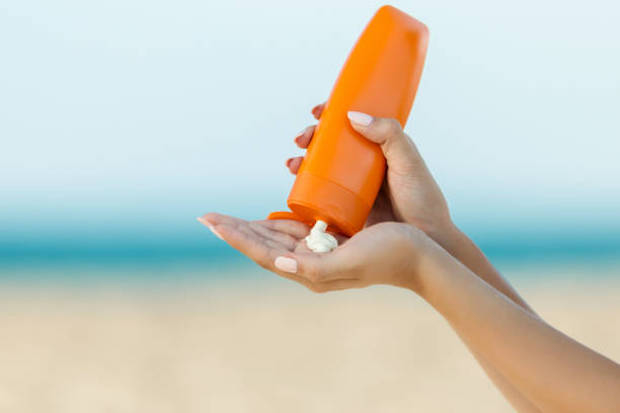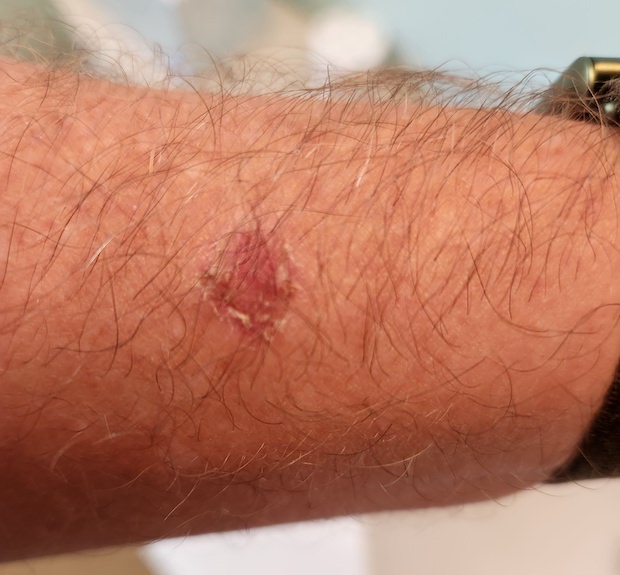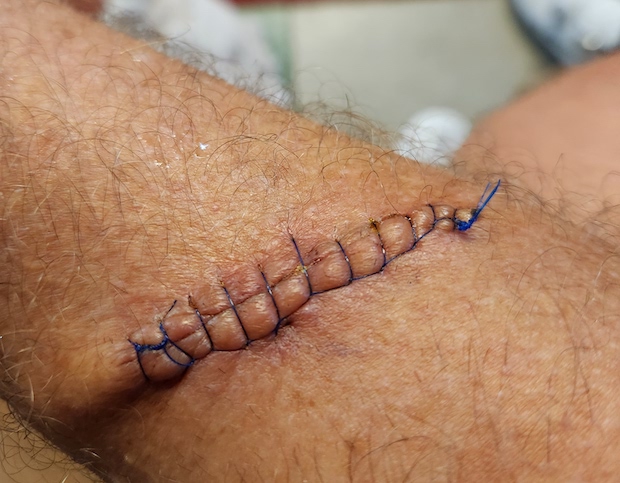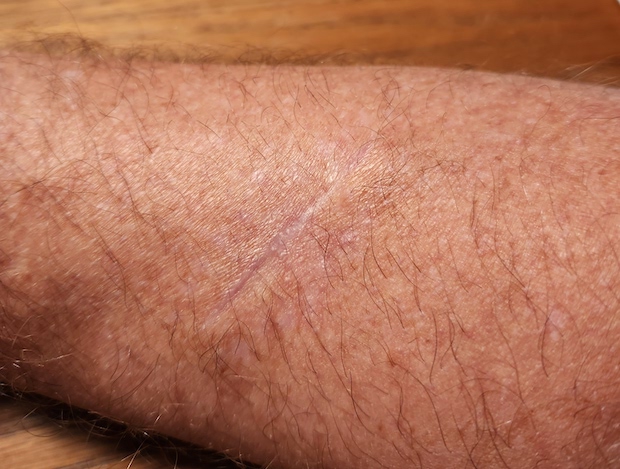Prevent Skin Cancer

May 27th is National Sunscreen Day.
If you would have told me there was a day designated for recognizing the importance of wearing sunscreen, I would have shrugged you off and ignored you. That is before I ended up in the office of a dermatologist getting two gnarly excisions on my forearms.
Warning: This article contains potentially disturbing images.
Like many of you I suspect, I never worried about sunscreen. As a white guy of Eastern European descent, I tan easy. I considered my sharp tan lines on my legs and arms to be an indicator of my fitness. The darker the tan indicated the greater number of miles I had put in training and racing.
Collectively in the predominately white peloton, the more tan we were indicated how far we were in the season of racing, as we shed winter thermal clothes for summer kits and skinsuits. In the Midwest, if we saw someone at a race with an unseasonable tan, it indicated that they may have been down in Florida doing some winter criteriums and could be on good form early in the season and therefore needed to be marked in the race.
As silly as all of this sounds now, wearing sunscreen never crossed our minds. I think in 30+ years of racing, I only knew one teammate who regularly applied sunscreen before heading out to train or lining up to race. We shared some faulty logic in the bad old days like a tan would provide protection from the sun and sunscreen would interfere with your body’s ability to sweat and cool itself.
However, when I moved to Atlanta 12 years ago, the group I regularly rode with on Sundays contained a number of older, veteran cyclists who wore thin, white arm warmers no matter how high the temperature. I understood that they were wearing them for protection from the sun, but again I shrugged it off as a sign of age. At the time, I was in my late 30s and not at all concerned about the damage I was doing to my skin.
Flakey Skin Spots

Last year, I noticed these small patches of dry, flakey skin about the size of a dime, one on each of my forearms. I didn’t think much of them and occasionally applied whatever moisturizing lotion was in the bathroom closet. However, they wouldn’t go away, and occasionally they would crack and bleed. I figured they would heal on their own eventually.
My wife, Erin, was regularly telling me that I needed to go to a dermatologist and have them checked out. I would always agree, but then do nothing about it. Then, I read on social media about a colleague who bravely shared her experience with skin cancer on her face and the subsequent surgery to have it removed. That was the final push I needed to schedule an appointment with a dermatologist.
Biopsy and Surgery
My dermatologist did not like the looks of my two flakey spots. Initially, she tried to freeze one spot to kill off any potentially bad cells and performed a biopsy of the other one. However, the freezing didn’t help, and that spot would also need to be biopsied. Tests for both spots came back basal cell carcinoma. In the world of skin cancer, that’s arguably the least worrisome cancer to have. Though basal cells are locally aggressive and spread locally on the skin, it’s typically not a form of cancer that spreads beyond the skin. However, it is still cancer and needs to be taken care of, lest the spot becomes bigger and more skin needs cut out.

The excision surgery is gnarly. The spots were the size of dimes, so that meant that my dermatologist had to cut out a spot the size of a quarter to make sure she removed all the basal cells. And, she also had to cut a thru line across the spot, so that she could have a seam to stretch the skin and sew the whole thing closed. The procedure is as medieval as it sounds, and you are awake for the whole thing. I made sure to look the other direction while my dermatologist was hacking away and sewing me shut. The result is a surprisingly large sewn up incision for the size of skin cancer spot. However, the scarring is just as surprising in that it’s pretty minor compared to what it seemed it would be, blending in with the other scars on my arms from years of bike racing.

Prevention and Care
These days I’m taking much better care of my skin. In particular, my arms and legs have significant more sun damage than other parts of my body – I think I have permanent tan lines that will never fade completely. Therefore, I’m paying particular attention to those sun damaged areas and applying sunscreen to them when headed outdoors. I am also acknowledging that most cycling clothing doesn’t provide much protection from the sun (maybe a SPF of 4 or 5), and I need to take care of those parts of my body too.
Following the recommendations of my dermatologist, here are changes that I have made to be more protected from the sun.
– Applying sunscreen that is broad spectrum, water resistant, and at least SPF 30. But also acknowledging that I may need to reapply throughout the day if I’m in the water or sweating a lot.
– Wearing long sleeve jerseys on long training rides. Our team clothing provider offers a summer weight long sleeve jersey. It’s not much more additional protection than the sunscreen, but I figure it can only help.
– Wearing white sun sleeves when training and racing. I’ve gotten over the stigma that those white thin sleeves with UV protection are for older athletes (either that or I’ve accepted I am one of those older athletes). Castelli offers a pair that has UPF 50+ protection.
– Annual appointment with my dermatologist. Veteran athletes have lots of -ologists who keep them moving and in good health. I shouldn’t have waited so long to start caring for my skin.
Coda
My skin cancer was preventable. Years and years of not even thinking about sun protection landed me in surgery. I didn’t even entertain the idea that I might have a problem even with two worrisome spots on my forearms that wouldn’t go away. It took reading about a colleague’s skin cancer before doing anything about mine.
My purpose in writing this up for Slowtwitch is that this article could potentially be that wake-up call for you to start taking care for your skin and seek the advice of a dermatologist if you have any concerns. As endurance athletes who are outside in the sun as much as we are, we should all be getting annual checks by a dermatologist.
Before you head out for your next training session, grab that sunscreen and apply it liberally. My dermatologist tells me that we often only get half of the SPF listed on the bottle because we don’t apply enough!




Start the discussion at forum.slowtwitch.com